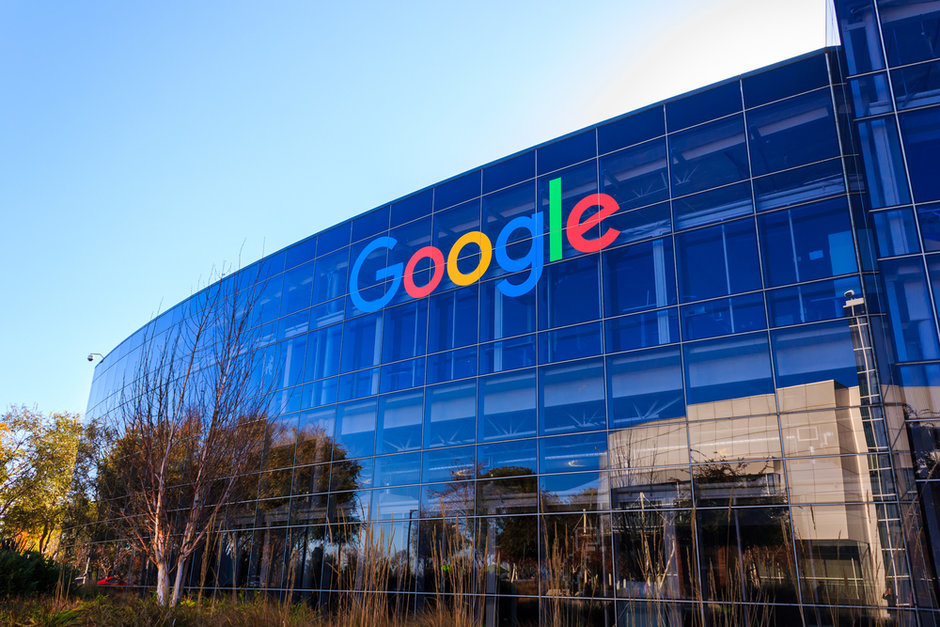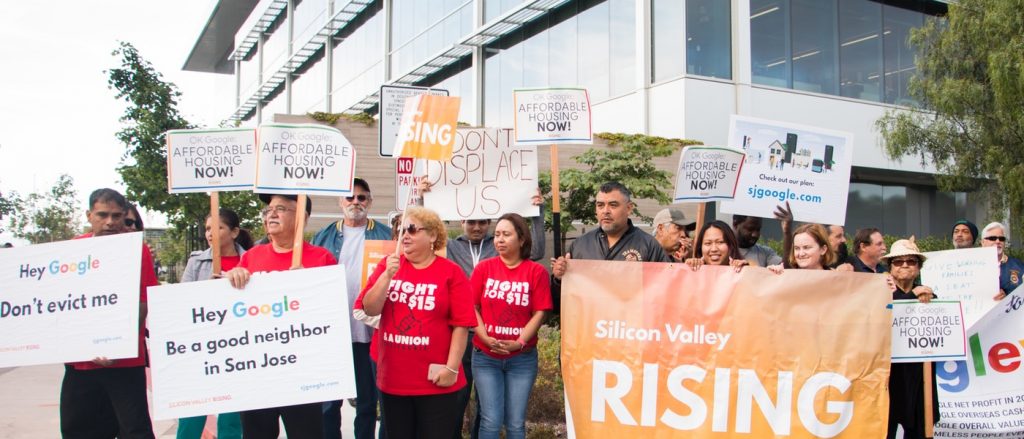How a $40,000 SPARCC grant helped community organizers show Google what was needed to prevent displacement of working families in San José

Google has announced it is committing $1 billion for new housing across the San Francisco Bay Area. The tech giant promises to build 20,000 new residences (including 5,000 affordable homes) over the next 10 years to help mitigate the impact of its new development across the region, including 28,000 more workers when its new office opens in San José. The announcement was met with cheers from the working-class families in San José who have faced fast-rising rents even before Google’s announcement, and who would likely feel even more pressure with the influx of thousands of Google employees in need of a place to live.
Two groups in particular were cheering—Working Partnerships USA (WPUSA) and Silicon Valley Rising. For them, two years of organizing was paying off. Most recently, and with support from Bay Area for All (BA4A), a collaborative of the Strong, Prosperous, And Resilient Communities Challenge (SPARCC) initiative, the groups had commissioned an impact study of Google’s office expansion on local housing markets. The report came out a week before Google’s announcement.
The story of the groups’ campaign, culminating in the influential impact report, can serve as a model for the tech industry on how to grow and develop without triggering displacement.
A Rumor Emerges
The rumors started to fly in early 2017: Google was buying up land in downtown San José for a new campus. While the prospect of more jobs in a region is always welcome, the impact of high-wage tech workers on local housing markets was well-trod ground in the Bay Area. The region already had one of the highest-cost real estate markets in the nation and a new Google campus would only add to the pressures local community members faced.
By June the mayor of San José confirmed the rumors. Google was intent on building a new campus in the city. In December the mayor announced that the City was selling Google the public land near the Diridon train station for $110 million. With up to $10 billion in transit investments coming down the pike in the next several years, that public land was suddenly some of the most valuable in the city, according to Jeffrey Buchanan, WPUSA’s director of public policy.
“This will be one of the largest tech campuses in the Valley, and one that involves public land, so we want to ensure that it’s not displacing more working-class families,” he said.
Silicon Valley Rising, a coalition of labor, faith, and community groups working to build a tech economy that considers the interests of working families, began organizing immediately, holding a series of town halls with more than 700 community members seeking answers to their questions on affordable housing, wages, and more. In 2018, the campaign sent two members to attend Google’s shareholder meetings while others protested outside.
By the end of 2018, Google had put housing on its agenda. Google offered the City of San José a nonbinding memorandum of understanding, said Buchanan. In the memorandum, Google agreed to pay impact fees and to make other contributions to affordable housing as it developed its plan for the public land, now rezoned to allow for taller (and thus more valuable) buildings. A community benefits agreement would outline ways to capture the value of that upzoning, though none of the agreements were legally binding.
Putting the Pressure On
This was all well and good, said Buchanan, but community members wanted more than a promise. And since data talks, they decided to quantify the impact of the campus on local rents and displacement. They turned to BA4A, which had been providing some operating funding, and whose focus on using public land to advance more equitable development was well aligned with the project. BA4A gave the two organizations a $40,000 grant to commission a report by Beacon Economics, a well-respected economic research group familiar to many policymakers in the region.
“We thought it’d be a helpful tool to educate the community and hold Google accountable,” said Buchanan. “We wanted to show Google what kind of housing response would be needed for them to be the first tech campus to cause no displacement.”

Image courtesy of Working Partners USA
The report turned heads. Findings showed that with Google’s new campus, renters in Santa Clara County would collectively be hit with a $235 million annual rent hike by 2030, or an additional $816 more each year. People of color would be the hardest hit. All this on top of the fact that rents for the typical home had already risen three times faster than median wages between 2010 and 2017. Median wages rose 21 percent in the region while median rents rose 69 percent.
“We couldn’t have done the report without BA4A support,” said Buchanan. “We had the idea — How do we put a number on this? — but we didn’t have the funds to do it.”
Part of the pressure on rents comes from the sheer lack of new housing. The study finds that while payroll jobs in Santa Clara County (where San José is located) grew 29 percent between 2010 and 2018, just 6 percent more homes were built. To curb the inevitable rent hikes from lack of supply, the report called on Google to build 5,284 affordable homes and 12,450 market-rate units. One-thousand of the units, they argued, should be affordable for extremely low-income renters.
Those specific recommendations would prove important.
Looking Google in the Eye
“We were initially just going to make it straight impact numbers,” said Buchanan. “Ultimately we decided not only to show what Google’s impact would be, but also what actions Google could take to prevent rent hikes and displacement.” They also were able to sharpen the report’s key research questions after ongoing discussions with the BA4A organizations and housing experts, making the report more focused and actionable.
The report received wide media coverage, and WPUSA and Silicon Valley Rising kept the pressure on with a social media campaign, including an open letter to Google CEO Sundar Pichai by Yolanda Chavez, a long-time resident who must now sublet her living room and a bedroom to afford her rent.
“I’m coming [to the shareholders meeting] to look you in the eye and ask what commitments you’ll make so your San José mega-campus doesn’t push out people like me,” she wrote.
Perhaps Google was listening. A few days later, at the company’s annual shareholders’ meeting, Chavez was there to present a list of questions to the board. She was standing in line for breakfast, said Buchanan, when Pichai approached her. He’d read her letter, he told her, and he said Google wanted to do everything it could to address the issues. In fact, Buchanan said, Pichai told her that Google had just made an announcement: $1 billion for 20,000 homes.
Google would provide $750 million in land and $250 million in an investment fund to support affordable housing. The $1 billion investment would build at least 5,000 affordable homes and 15,000 market-rate homes, almost exactly the number of homes the WPUSA report had called on Google to build.
Keeping the Momentum, Building a Model
Though the details have yet to be hashed out, and $250 million only goes so far when it costs about $425,000 per unit to build housing in the Bay Area, Buchanan says he is excited.
“It’s still a large, and good, commitment,” he said, and the organizing and hard evidence from the impact report has led to real change. “The most important part of the commitment is that a big tech company admits to being part of the problem and wants to be part of the solution. We have a long way to go to fully address the scale of the impact,” said Buchanan, “but this is a good start.”
The two groups will stay on the frontlines of the fight, Buchanan said. “We’ve been out on the streets working on this for two years. It’s clear we’re making progress, but we’re going to keep holding Google accountable.”
It will be an uphill battle, as others note, given the 10-year timespan that Google has set for the project. That is a long time for often underfunded advocacy organizations to sustain the fight, particularly after the media’s spotlight shuts off.
Questions on the docket for Google going forward, say advocates, include how does Google stay accountable to this commitment? How will these investments make it easier for affordable developers, land trusts, and others to produce affordable housing? And what is the level of affordability embedded in this commitment to ensure the resources serve the communities that Beacon’s report found will be most impacted?
In the end, Buchanan said, “There’s an opportunity here to create a model for showing the tech industry how to develop without displacement.”